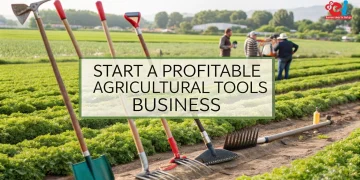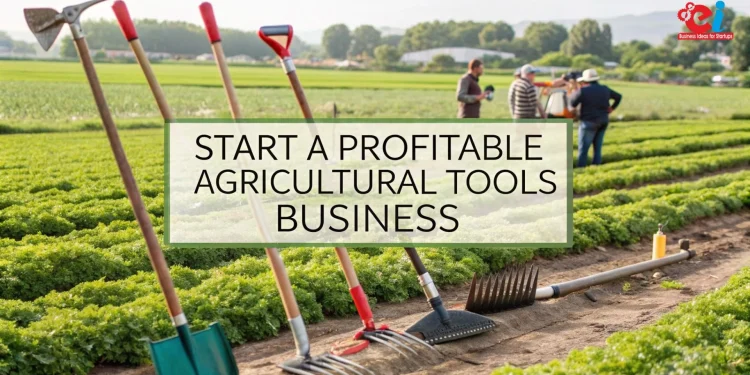Change is being witnessed in India’s agriculture and horticulture. With urban areas taking on gardening as a hobby and modernization spreading to rural areas, there is an unprecedented need for affordable, lightweight, and well-designed gardening and agricultural tool. One of the most commonly used tools, the spade for gardening and agriculture, fulfills soil and plant cultivation needs. This is of great interest to entrepreneurs, particularly at the Micro, Small, and Medium Enterprises (MSME) level.
The agricultural tool industry in India is undergoing an accelerated change from unorganized to organized. The new world with greater concern for the environment and higher disposable incomes encourages quality hand tools among hobby gardeners and small scale farmers. This is highly beneficial for MSMEs planning to enter the market as manufacturers or distributors of basic gardening and agriculture tools such as spades, shovels, hoes, rakes, and trowels. This article explores the burgeoning demand for agriculture and gardening spades in India, the current situation within the supply chain, investment viability, and the role of NPCS as a service consultant for entrepreneurs.
The Increase in Popularity of Agricultural and Yard Spades
In India’s farming regions as well as in urban households, the gardening and agricultural spade is one of the most commonly used handheld tools. It serves key functions in digging, turning soil, transplanting seedlings, edging, and compost management. Its demand is stable owing not only to rural farming activities as well as urban landscape gardening, rooftop farming, greenhouse gardening, and the ever-increasing trend of DIY gardening amongst millennials.
Spades are carving in rural India as it is ncedibleon small and marginal farms as well as where mechanization is hardly found. They are remarkably useful in inter-cropping zones, wetland paddy farming, and terrace cultivation. The creation of organized housing societies alongside eco-friendly suburban homeowners have led to a surge in home gardening. The National Horticulture Mission from the Government of India encouraging kitchen gardening has increased demand for quality spades even more among urban households.
As per the latest available estimates, the size of Indian market for hand tools used for agriculture and gardening is estimated to be growing at a CAGR of 7% and is set to surpass ₹3,000 crores by the year 2030. Within this category, spades used in agricultural tool constitute almost 20% of the total volume traded. With the government also subsidizing tools through various Agricultural Subsidy Schemes for small and marginal farmers, the opportunities for quality spade manufacturers has never been greater.
Related: India’s Agriculture Sector: Its Role in Government Initiatives
Target Customer Segments and Usage Trends
The wide array of customers across the board including small scale farmers, commercial floriculturists, nursery growers, realtors, and organic farming cooperatives make up the primary customer base for spades. All of these segments require tailered solutions in design, blade dimensions, weight, and handle ergonomics which adds to the ease for manufacturers to devise competitive differentiation strategies.
For year-round fieldwork, marginal farmers are highly cost sensitive while requiring a spade that is durable. Unlike urban users who look for lightweight, rust-proof tools with powder coating and wooden or plastic grips. Nurseries and floriculture businesses make use of multiple types of spades for soil aeration and transplantation while elementary landscaping agencies purchase spades in bulk, emblazoned with the company logo, which increases B2B opportunities.
The increasing appreciation of ergonomics and efficiency is changing the demand spades with composite handles and grips that do not slip, along with blades of steel that resist rust. For local MSMEs, this is an opportunity to move from basic iron cast designs to more advanced premium spades with greater margins.
Potential Manufacturing Opportunities with MSMEs: Materials, Processes and Equipment
Setting up a medium or small scale spade manufacturing unit is not technically complex, offering ample profitability and opportunities for growth. The primary raw materials include mild steel or stainless steel for the blades, wooden or plastic handles, anti-corrosive coatings, riveting materials, and packing materials for retail.
The process includes sheet metal cutting, forging or stamping of blades, edge grinding, fitting of the handles, surface treatment by galvanizing or painting, finishing, testing for quality, and packaging. Essential equipment includes power press machines, cutting dies, drills for handles, and grinders. An average plant that can produce 5,000–10,000 spades a month can be built with an initial investment of 35 to 50 lakhs in rupees, depending on the level of automation.
The establishment can be set up in a space between 3,000 to 5,000 square feet and operated with a minimum 10 to 15 skilled and semi-skilled workers. Energy expenses are reasonable, and further scaling of the unit is possible by adding more hand tools while using the same infrastructure. This model is the best fit for MSMEs interested in investing in the rural Agricultural tool making industry due to its low capital requirements, minimal risks, and high flexibility.
Distribution Channels and Sales Avenues
Spades are available in both B2B and retail stores. Rural areas are supplied by local agricultural co-operative stores, fertilizer shops, and tool retail stores. Urban areas are well supplied by gardening tools retail outlets, home improvement shops, nurseries, and various ecommerce sites.
Premium gardening tool brands have recently broadened their portfolios with spades sold through their own websites, Amazon, Flipkart, Ugaoo, Trust Basket, Nurserylive, and other niche sites. Institutional sales to government sponsored parks, NGO sponsored village parks, and government horticulture programs also provide stable repeat purchases.
New export markets are developing towards Africa, South-East Asian countries, and Middle Eastern nations. These regions consider India as a center for low priced agricultural implements. Spades manufactured by Indian MSMEs have gained popularity among bulk shipments catering to agro-startup kits and NGO funded livelihood projects.
Related: The Agriculture Sector in India
Government MSME Schemes
The Indian government supports agricultural tool manufacturing under the Agricultural tool Mechanization Sub-Mission (SMAM) and PMEGP – Prime Minister’s Employment Generation Programme. They offer subsidized machinery purchases, marketing assistance, and other MSME-specific incentives which ease the establishment of such units in semi-urban and rural areas.
Along with those, the Credit Linked Capital Subsidy Scheme (CLCSS), MUDRA, and Stand-Up India schemes grant entrepreneurs lower interest rate funding for investments in hand and spade tools. Registering with Udyam and NSIC provides quick registration for the priority lending scheme and tendership free access.
This allows them to unlock the potential of these supporting initiatives to improve cluster level tool testing centers, co-operative procurement agreements, and even ISO design aid for product standardization. These registrations coupled with the right approach will help MSMEs claim the benefits within these frameworks with ease.
Financial Viability and Profit Margin
The monthly production of spades is 6,000 units at an average cost of ₹90 per unit, which includes expenses such as raw materials, labor, utilities, and overheads. The wholesale price can be set between ₹160–₹180 per unit, which would lead to a monthly revenue of roughly ₹10–11 lakhs, translating to an annual revenue exceeding ₹1.2 crore.
The business has a profit margin anywhere between 35% to 40% when it comes to bulk sales, with margins reaching upwards of 50% for direct sales, allowing for an initial investment payback period of 2–3 years. Custom brand labeling for export shipments and expansion into other tools like sickles, hoes, and trowels would increase profitability.
How NPCS Helps New Entrepreneurs Enter the Agricultural Tool Segment
For MSME investors, transitioning from idea to execution can be daunting without professional assistance. This is where Niir Project Consultancy Services (NPCS) plays a pivotal role. With decades of experience in developing Techno-Economic Feasibility Reports, Market Research Studies, and Startup Business Plans, NPCS is enabling Indian entrepreneurs to confidently invest in spade and gardening tool ventures.
NPCS provides tailored reports covering raw material sourcing, manufacturing process workflows, machinery list with supplier details, cost and revenue modeling, regulatory compliance needs, and marketing strategy development. Whether it is preparing a Detailed Project Report (DPR) for loan applications or assessing market potential in a specific state, NPCS delivers actionable business intelligence.
Future Outlook and Conclusion
The market for agricultural and gardening spades in India is poised for robust growth. With the rise in small-scale farming, permaculture, home gardening, and an increasing focus on sustainable practices, demand for efficient and affordable hand tools is surging. The spade remains a vital, non-substitutable implement in every farmer’s and gardener’s toolkit.
For MSMEs, this sector offers a sweet spot of low entry barrier, consistent demand, high margins, and strong government support. The ability to diversify, cater to local needs, and even tap into global markets makes the opportunity even more attractive. With the right guidance, such as the comprehensive project support provided by Niir Project Consultancy Services, entrepreneurs can confidently navigate the setup and scaling of their business.
As India modernizes its agriculture and embraces greener lifestyles, the agricultural Tool and gardening spade represents more than just a tool—it is a gateway to building a reliable, impactful, and profitable MSME venture.


























